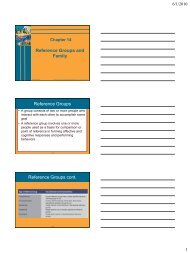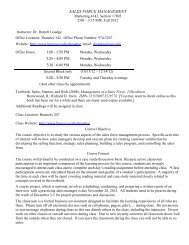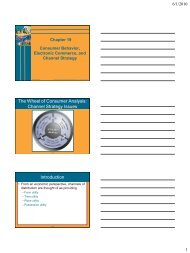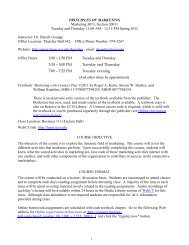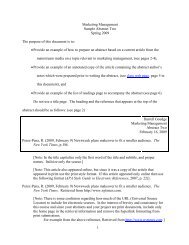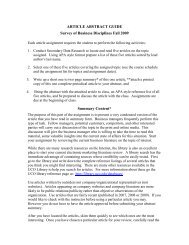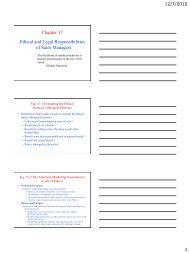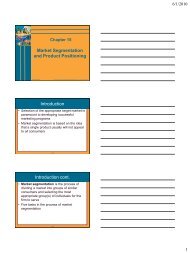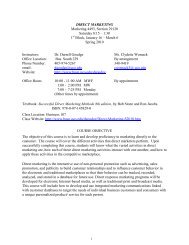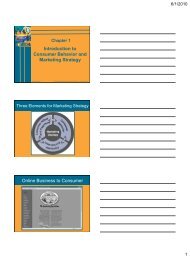Reference Groups and Family Learning Objectives Learning ...
Reference Groups and Family Learning Objectives Learning ...
Reference Groups and Family Learning Objectives Learning ...
Create successful ePaper yourself
Turn your PDF publications into a flip-book with our unique Google optimized e-Paper software.
7/8/2010<br />
Chapter 14<br />
<strong>Reference</strong> <strong>Groups</strong> <strong>and</strong><br />
<strong>Family</strong><br />
Chuck E. Cheese<br />
<strong>Learning</strong> <strong>Objectives</strong><br />
• Describe two aspects of the micro social<br />
environment<br />
• Discuss three types of reference group influence<br />
• Describe how reference groups could influence<br />
choice decisions about products <strong>and</strong> br<strong>and</strong>s, <strong>and</strong><br />
offered ideas for using reference groups in<br />
marketing strategies<br />
14-2<br />
<strong>Learning</strong> <strong>Objectives</strong> (cont.)<br />
• Distinguish between families <strong>and</strong> households<br />
• Discuss decision making by families<br />
• Look at conflict in family choices <strong>and</strong> describe<br />
several ways family members might try to<br />
resolve the decision conflict <strong>and</strong> influence each<br />
other<br />
14-3<br />
1
7/8/2010<br />
<strong>Learning</strong> <strong>Objectives</strong> (cont.)<br />
• Explore consumer socialization<br />
• Describe several demographic trends that have<br />
changed family households<br />
• Discuss a model of the family life cycle <strong>and</strong><br />
showed how marketers could use it to analyze<br />
markets <strong>and</strong> develop marketing strategies<br />
14-4<br />
<strong>Reference</strong> <strong>Groups</strong><br />
• A group consists of two or more people who<br />
interact with each other to accomplish some goal<br />
• A reference group involves one or more people<br />
used as a basis for comparison or point of<br />
reference in forming affective <strong>and</strong> cognitive<br />
responses <strong>and</strong> performing behaviors<br />
14-5<br />
Types of <strong>Reference</strong> <strong>Groups</strong><br />
Ex. 14.1, p. 339<br />
14-6<br />
2
7/8/2010<br />
Analyzing <strong>Reference</strong> <strong>Groups</strong><br />
• <strong>Reference</strong> groups are cultural groups in<br />
that members share certain common<br />
cultural meanings<br />
– Marketers try to determine the content of the<br />
shared meanings of various reference groups<br />
– <strong>Reference</strong> groups can have both positive <strong>and</strong><br />
negative effects on consumers<br />
• Associative reference groups<br />
• Dissociative reference groups 14-7<br />
Types of <strong>Reference</strong> Group Influence<br />
• Most people are members of several<br />
primary informal groups <strong>and</strong> a few formal,<br />
membership groups<br />
– People identify <strong>and</strong> affiliate with particular<br />
reference groups for three reasons<br />
• To gain useful knowledge<br />
• To obtain rewards or avoid punishments<br />
• To acquire meanings for constructing, modifying,<br />
or maintaining their self-concepts<br />
14-8<br />
Types of <strong>Reference</strong> <strong>Groups</strong> (cont.)<br />
–Three types of reference group influence<br />
• Informational<br />
• Utilitarian<br />
• Value-expressive<br />
–All three types of reference group<br />
influence can be accomplished by a<br />
single reference group.<br />
14-9<br />
3
7/8/2010<br />
<strong>Reference</strong> Group Influence on Products <strong>and</strong><br />
Br<strong>and</strong>s<br />
• <strong>Reference</strong> groups do not influence all product <strong>and</strong><br />
br<strong>and</strong> purchases to the same degree [Ex. 14.2, p. 343]<br />
– Influences vary on at least two dimensions<br />
• Degree to which the product or br<strong>and</strong> is<br />
– A necessity<br />
– A luxury<br />
• Degree to which the object in question is<br />
conspicuous or know by other people<br />
– Public good<br />
– Private good 14-10<br />
<strong>Reference</strong> Group Influence on Products <strong>and</strong><br />
Br<strong>and</strong>s (cont.) Ex. 14.2, p. 343<br />
14-11<br />
<strong>Reference</strong> Group Influence on Products<br />
<strong>and</strong> Br<strong>and</strong>s (cont.)<br />
–<strong>Reference</strong> group influence will vary<br />
depending on whether the products <strong>and</strong><br />
br<strong>and</strong>s are<br />
• Public necessities<br />
• Private necessities<br />
• Public luxuries<br />
• Private luxuries<br />
14-12<br />
4
7/8/2010<br />
<strong>Reference</strong> <strong>Groups</strong> <strong>and</strong> Marketing<br />
Strategy<br />
• Developing marketing strategies through an analysis<br />
of primary informal group influences<br />
• Peer group influence as a major asset of firms that<br />
sell in-home to groups<br />
• Describing similarities between previous consumers<br />
<strong>and</strong> potential consumers<br />
• Using salespersons as reference groups<br />
• Soliciting experts to aid in the direct sale of products<br />
• Example of Pharmaceutical ads [Highlight 14.1, p. 345]<br />
14-13<br />
<strong>Family</strong><br />
• Marketers are interested in both families <strong>and</strong><br />
households<br />
– Household is the housing unit having people<br />
living in it<br />
– Nonfamily households include unrelated people<br />
living together<br />
– A family has at least two people, the householder<br />
<strong>and</strong> someone who is related to the householder by<br />
blood, marriage, or adoption<br />
• Nuclear family<br />
• Extended family<br />
14-14<br />
<strong>Family</strong> Decision Making<br />
• How family members interact <strong>and</strong><br />
influence one another when making<br />
purchase choices for the household<br />
– Identification of roles of family members in<br />
family decision making is important<br />
14-15<br />
5
7/8/2010<br />
<strong>Family</strong> Decision Making (cont.)<br />
–Types of family decision-making roles<br />
include:<br />
• Influencers<br />
• Gatekeepers<br />
• Users<br />
• Deciders<br />
• Buyers<br />
• Disposers<br />
14-16<br />
Influences on <strong>Family</strong> Decision Making<br />
• Areas explored in research on family<br />
decision making are<br />
– Differences in product class <strong>and</strong> their<br />
relationship to family decision making<br />
– The structure of husb<strong>and</strong>/wife roles<br />
– The determinants of joint decision making<br />
• Children <strong>and</strong> family decision making<br />
14-17<br />
Conflict in <strong>Family</strong> Decision Making<br />
• Decision conflict arises when family<br />
members disagree about some aspect of the<br />
purchase decision<br />
– Means-end chain model is a useful framework<br />
for analyzing decision conflict<br />
14-18<br />
6
7/8/2010<br />
Six Common Types of <strong>Family</strong> Influence<br />
Strategies Ex. 14.3, p. 348<br />
Patterns or Styles of Influence Behaviors<br />
Ex. 14.4, p. 349<br />
Consumer Socialization<br />
• Refers to how children acquire knowledge about<br />
products <strong>and</strong> services <strong>and</strong> various consumptionrelated<br />
skills<br />
– Can occur directly through intentional instruction or<br />
indirectly through observation <strong>and</strong> modeling<br />
– The consumer knowledge formed in childhood can<br />
influence people in later years<br />
14-21<br />
7
7/8/2010<br />
Consumer Socialization (cont.)<br />
– Developing early br<strong>and</strong> awareness <strong>and</strong> loyalty<br />
is an important marketing strategy for many<br />
companies<br />
– The flow of socialization is not restricted to<br />
parents influencing their young children<br />
14-22<br />
Factors Influencing American Families<br />
• Three important changes:<br />
– Changes in female employment<br />
[ Avon - Highlight 14.2, p. 351]<br />
– Changes in marriage <strong>and</strong> divorce<br />
• Age at first marriage [1890-2009, 1940-2009, 2000-2009]<br />
– Changes in childbirth <strong>and</strong> child rearing practices<br />
14-23<br />
29<br />
Age of First Marriage 1890 - 2009<br />
28<br />
27<br />
26<br />
25<br />
24<br />
Men<br />
Women<br />
23<br />
22<br />
21<br />
20<br />
19<br />
1880 1900 1920 1940 1960 1980 2000 2020<br />
Source: U.S. Census 2010<br />
8
7/8/2010<br />
29<br />
Age of First Marriage 1940- 2009<br />
28<br />
28.1<br />
27<br />
26<br />
25<br />
24<br />
23<br />
22<br />
21<br />
20<br />
24.3<br />
21.5<br />
27.5 27.5<br />
27.6<br />
27.4<br />
27.1 27.1 27.1<br />
26.9<br />
26.8<br />
26.9<br />
26.8<br />
26.9 26.9<br />
26.7 26.7<br />
26.5 26.5<br />
26.3<br />
26.2<br />
26.1<br />
25.9<br />
25.9 25.9<br />
25.8<br />
25.7<br />
25.6<br />
25.5<br />
25.5<br />
25.4 25.4<br />
25.3 25.3 25.3 25.3<br />
25.2<br />
25.1 25.1 25.1<br />
25 25<br />
24.8<br />
24.8<br />
24.7<br />
24.4<br />
24.4<br />
24.5 24.5 24.5<br />
24.2<br />
24.1<br />
24<br />
23.9<br />
23.8<br />
23.8<br />
23.7<br />
23.6 23.6<br />
23.5<br />
23.3<br />
23.3<br />
23.3<br />
23.2 23.2 23.2<br />
23.1 23.1 23.1 23.1 23.1<br />
23.1<br />
23 23<br />
23<br />
22.9<br />
22.7<br />
22.8 22.8 22.8 22.8<br />
22.7<br />
22.8 22.8 22.8<br />
22.8<br />
22.6<br />
22.5<br />
22.6 22.6<br />
22.5<br />
22.5<br />
22.3<br />
22.1<br />
22<br />
21.8<br />
21.6<br />
21.3<br />
21.1 21.1<br />
21<br />
20.9 20.9<br />
20.8 20.8 20.8<br />
20.6 20.6<br />
20.5<br />
20.4 20.4<br />
20.5 20.5 20.5<br />
20.3 20.3 20.3 20.3 20.3 20.3 20.3<br />
20.2 20.2 20.2<br />
20.1<br />
20.2 20.2<br />
1940 1950 1960 1970 1980 1990 2000 2010 2020<br />
Men<br />
Women<br />
28.5<br />
Age of First Marriage 2000-2009<br />
28<br />
27.5<br />
27<br />
26.5<br />
Men<br />
Women<br />
26<br />
25.5<br />
25<br />
24.5<br />
2000 2001 2002 2003 2004 2005 2006 2007 2008 2009 2010<br />
Demographic Changes in Household<br />
Composition<br />
• American families are highly diverse<br />
–Various types of families constitute<br />
distinctive markets for many products<br />
• Married-couple family<br />
• Traditional family<br />
• Nontraditional family<br />
• Nonfamily households family<br />
– Cohabiting couples<br />
14-27<br />
9
7/8/2010<br />
<strong>Family</strong> Life Cycle<br />
Ex. 14.5, p. 355<br />
• The modern family life cycle captures most<br />
types of families in American society,<br />
including:<br />
– Single parents<br />
– Young singles<br />
– Older singles<br />
– Married couples with children<br />
14-28<br />
A Modern <strong>Family</strong> Life Cycle<br />
Ex. 14.5, p. 355<br />
14-29<br />
<strong>Family</strong>- Marketing Analysis<br />
• Considerations for using the family life<br />
cycle for marketing analysis<br />
– Modern family life cycle does not include<br />
nonfamily households<br />
– Modern family life cycle does not capture<br />
every possible change in family status that can<br />
occur<br />
• Does not include the boomerang age<br />
14-30<br />
10
7/8/2010<br />
<strong>Family</strong>- Marketing Analysis (cont.)<br />
– Marketers use the family life cycle to:<br />
• Segment the market<br />
• Analyze market potential<br />
• Identify target markets<br />
• Develop more effective marketing strategies<br />
– Developing marketing strategies for the bachelor<br />
segment is a challenge<br />
– Some stages in the family life cycle are more<br />
important markets than others<br />
– Stages of the family life cycle that contain<br />
14-31<br />
children are quite important to many marketers<br />
<strong>Family</strong>- Marketing Implications<br />
• Ethical Considerations [Highlight 14.3, p. 358]<br />
• Ideas for marketing strategies to help<br />
reduce shopping time <strong>and</strong> stress<br />
– Provide information<br />
– Assist in planning<br />
– Develop out-of-store selling<br />
– Automate processes<br />
– Improve delivery<br />
14-32<br />
Summary<br />
• Described two aspects of the micro social<br />
environment<br />
• Discussed three types of reference group<br />
influence<br />
• Described how reference groups could influence<br />
choice decisions about products <strong>and</strong> br<strong>and</strong>s, <strong>and</strong><br />
offered ideas for using reference groups in<br />
marketing strategies<br />
14-33<br />
11
7/8/2010<br />
Summary (cont.)<br />
• Distinguished between families <strong>and</strong> households<br />
• Discussed decision making by families<br />
• Looked at conflict in family choices <strong>and</strong><br />
described several ways family members might<br />
try to resolve the decision conflict <strong>and</strong> influence<br />
each other<br />
14-34<br />
Summary (cont.)<br />
• Explored consumer socialization<br />
• Described several demographic trends that have<br />
changed family households<br />
• Discussed a model of the family life cycle <strong>and</strong><br />
showed how marketers could use it to analyze<br />
markets <strong>and</strong> develop marketing strategies<br />
14-35<br />
12



